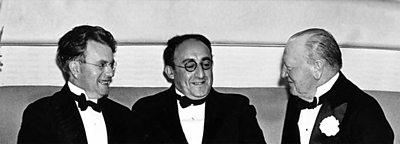As one of the pioneers of television, John Logie Baird has been written about a great deal over the years. The image we get from these accounts is of an unworldly, somewhat lonely figure dedicated to science, whose work wasn’t fully appreciated in his lifetime. The accounts contained in the ��������’s Oral History collection do little to contradict any of this. But they also reveal a great deal of sympathy for him on a personal level, and some embarrassment about how the �������� dealt with him.
In his interview, the �������� engineer Tony Bridgewater – who worked directly for Baird before joining the �������� – described the Scotsman as “quiet, reserved, shy, very polite, not quite with you, you… sensed he was probably thinking of something else”. Bridgewater also gives a description of the ��������’s big ‘opening night’ of 2 November 1936, when the regular high-definition service was formally launched.
He noted that various bigwigs were at Alexandra Palace to take part in the opening ceremony – the Postmaster General, the chairman of Baird’s own company, and so on. But:
It was a very sad thing that poor old Baird, whom I think could have been treated a bit better, wasn’t invited to sit among the party and he was left walking up and down the corridor outside – very bitter, very upset about that.
Recalling the ��������’s decision in 1937 to finally reject his mechanical system completely in favour of the rival electronic one, another engineer, Harold Bishop, described Baird as being “cast out”: “the whole thing was a bit unpleasant”.
Perhaps the most intimate account from the �������� Oral History collection, though, comes from Stuart Williams, who’d joined the �������� as a junior sub-editor on the Radio Times, when he was sixteen years old, and later worked in outside broadcasts. Through a family connection he saw “quite a lot” of Baird at home in the early-1930s – and so got to know him in his most private moments:
In reality, Baird had very little direct contact with the ��������, preferring to concentrate on his laboratory work. Most of the negotiating between Baird’s television company and the Corporation or the Post Office was conducted by another important figure, Sydney Moseley.
Moseley had been a prominent radio critic for several newspapers and magazines, and took it upon himself to campaign vociferously on behalf of Baird’s technology. He delighted in presenting the ��������’s reluctance over Baird’s mechanical system as a David and Goliath struggle. Unfortunately, he constantly made exaggerated claims for the technology – claims the �������� knew to be false, and which appeared to the Corporation to present a serious risk of destroying an already fragile public faith in the new medium.
It was through Sydney Moseley that Stuart Williams had met Baird – because Moseley was his father-in-law. This brought Williams into regular contact with the man he describes in his �������� Oral History interview as “the power behind Baird”:
-
First published in 1972, �������� Publications ©1972. PDF version with thanks to Nick Cutmore and Philip Laven.

